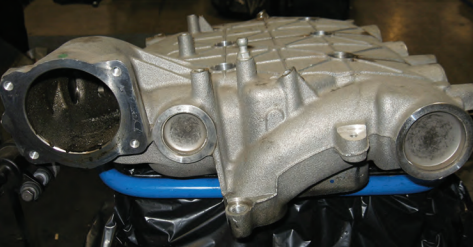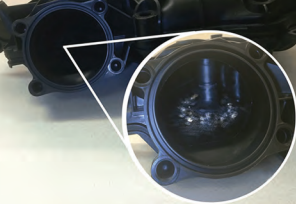REPLACING AN ENGINE? KEEP THESE STEPS IN MIND!

When replacing an engine that has suffered internal breakdown, two important parts that also may need to be replaced are the intake manifold and the catalytic converter.
Intake Manifold
For the intake manifold, internal-engine damage could have left debris inside the manifold via broken pistons or bent, broken or missing intake valves, for example.
After removing the intake manifold from the engine, it’s important to carefully inspect all cylinder-head intake ports to see whether the valve heads are all still present and unaffected. If the valve heads are bent, damaged or missing, then there is likely component debris in the intake port and the intake manifold should be replaced.
Because most intake manifolds have a complex inlet runner and plenum configuration, it’s almost impossible to completely clean the component and verify that all debris has been removed. If a dirty intake manifold is reinstalled, it could result in any remaining debris being ingested by the new GM Genuine Parts service engine, causing damage or potential failure of the new engine’s long block.
Catalytic Converter
If an engine breaks down, such as from a broken intake or exhaust valve or piston, debris could get left in the catalytic converter through engine exhaust ports. If the engine isn’t functioning because of severe overheating, there could be damage to the ceramic brick inside the catalytic converter. If that happens, material or metal can get sucked back into the replacement engine during valve overlap and be sent throughout the intake manifold and into the cylinder.
This can cause heavy wear to piston rings and cylinder walls and can result in misfires and oil consumption. The replacement engine could fail because of the remaining debris being sent into the combustion chambers when the vehicle is started.
As a result, an inspection of the catalytic converters and all transferred components should be performed when replacing an engine, and all debris should be removed. In the case of an engine failing from severely overheating, dealers should also inspect each catalytic converter for signs of melting or cracking in the ceramic brick. If any damage is seen, the converter should be replaced.

This is a view of a broken valve that blew debris back into the intake from the combustion chamber.
For more Tech Tips, visit our blog page by clicking here.
When replacing an engine that has suffered internal breakdown, two important parts that also may need to be replaced are the intake manifold and the catalytic converter.
Intake Manifold
For the intake manifold, internal-engine damage could have left debris inside the manifold via broken pistons or bent, broken or missing intake valves, for example.
After removing the intake manifold from the engine, it’s important to carefully inspect all cylinder-head intake ports to see whether the valve heads are all still present and unaffected. If the valve heads are bent, damaged or missing, then there is likely component debris in the intake port and the intake manifold should be replaced.
Because most intake manifolds have a complex inlet runner and plenum configuration, it’s almost impossible to completely clean the component and verify that all debris has been removed. If a dirty intake manifold is reinstalled, it could result in any remaining debris being ingested by the new GM Genuine Parts service engine, causing damage or potential failure of the new engine’s long block.
Catalytic Converter
If an engine breaks down, such as from a broken intake or exhaust valve or piston, debris could get left in the catalytic converter through engine exhaust ports. If the engine isn’t functioning because of severe overheating, there could be damage to the ceramic brick inside the catalytic converter. If that happens, material or metal can get sucked back into the replacement engine during valve overlap and be sent throughout the intake manifold and into the cylinder.
This can cause heavy wear to piston rings and cylinder walls and can result in misfires and oil consumption. The replacement engine could fail because of the remaining debris being sent into the combustion chambers when the vehicle is started.
As a result, an inspection of the catalytic converters and all transferred components should be performed when replacing an engine, and all debris should be removed. In the case of an engine failing from severely overheating, dealers should also inspect each catalytic converter for signs of melting or cracking in the ceramic brick. If any damage is seen, the converter should be replaced.
This is a view of a broken valve that blew debris back into the intake from the combustion chamber.
For more Tech Tips, visit our blog page by clicking here.